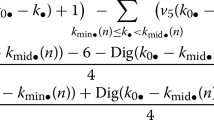Abstract
In this computational paper we verify a truncated version of the Buzzard–Calegari conjecture on the Newton polygon of the Hecke operator \(T_2\) for all large enough weights. We first develop a formula for computing p-adic valuations of exponential sums, which we then implement to compute 2-adic valuations of traces of Hecke operators acting on spaces of cusp forms. Finally, we verify that if Newton polygon of the Buzzard–Calegari polynomial has a vertex at \(n\le 15\), then it agrees with the Newton polygon of \(T_2\) up to n.
Résumé
Dans cet article, nous vérifions une version tronquée de la conjecture de Buzzard–Calegari concernant le polygone de Newton de l’opérateur Hecke \(T_2\) pour tous les poids suffisamment grands. Nous développons d’abord une formule pour les valuations p-adiques de sommes exponentielles, que nous utilisons ensuite pour calculer les valuations 2-adiques des traces d’opérateurs de Hecke agissant sur des espaces de formes cuspidales. Enfin, nous vérifions que si le polygone de Newton du polynôme de Buzzard–Calegari a un sommet en \(n\le 15\), alors il coïncide avec le polygone de Newton de \(T_2\) jusqu’à n.
Similar content being viewed by others
References
Baba, S., Murty, R.: Irreducibility of Hecke polynomials. Math. Res. Lett. 10, 709–715 (2003)
Bergdall, J., Pollack, R.: Slopes of modular forms and the ghost conjecture. Int. Math. Res. Not. 20, 1125–1144 (2019)
Bombieri, E., Katz, N.: A note on lower bounds for Frobenius traces. Enseign. Math. (2) 56(3–4), 203–227 (2010)
Brown, B., Calkin, N.J., Flowers, T.B., James, K., Smith, E., Stout, A.: Elliptic curves, modular forms, and sums of Hurwitz class numbers. J. Number Theory 128, 1847–1863 (2008)
Buzzard, K.: Questions about slopes of modular forms, no. 298. Automorphic forms. I, pp 1–15 (2005)
Buzzard, K., Calegari, F.: Slopes of overconvergent 2-adic modular forms. Compos. Math. 141, 591–604 (2005)
Chiriac, L., Jorza, A.: Data related to Newton polygons of Hecke operators. https://web.pdx.edu/~chiriac/data/traces.html
Emerton, M.: 2-adic modular forms of minimal slope. PhD thesis, Harvard University (1998)
Ghitza, A., McAndrew, A.: Experimental evidence for Maeda’s conjecture on modular forms. Tbil. Math. J. 5, 55–69 (2012)
Hatada, K.: Eigenvalues of Hecke operators on \({\rm SL}(2,\,{\bf Z})\). Math. Ann. 239, 75–96 (1979)
Hida, H., Maeda, Y.: Non-abelian base change for totally real fields, no. Special Issue. Olga Taussky-Todd: in memoriam, pp 189–217 (1997)
Knightly, A., Li, C.: Traces of Hecke Operators, vol. 133 of Mathematical Surveys and Monographs. American Mathematical Society, Providence (2006)
Liu, R., Wan, D., **ao, L.: The eigencurve over the boundary of weight space. Duke Math. J. 166, 1739–1787 (2017)
Lygeros, N., Rozier, O.: A new solution to the equation \(\tau (p)\equiv 0 \,({\rm mod} \, p)\). J. Integer Seq. 13, 11 (2010)
The Sage Developers: SageMath, the Sage Mathematics Software System (Version 8.7) (2019). https://www.sagemath.org
Schlickewei, H.P.: The number of subspaces occurring in the \(p\)-adic subspace theorem in Diophantine approximation. J. Reine Angew. Math. 406, 44–108 (1990)
Vonk, J.: Computing overconvergent forms for small primes. LMS J. Comput. Math. 18(1), 250–257 (2015)
Wan, D.: Dimension variation of classical and \(p\) -adic modular forms. Invent. Math. 133(2), 449–463 (1998)
Acknowledgements
We are grateful to Damien Roy for many useful suggestions, and especially for showing us the proof of Proposition 7, to the anonymous referee for encouraging us to work out the relationship between the Newton polygons of \(P_{T_2}\) and its truncation, and to John Bergdall for helpful conversations.
Author information
Authors and Affiliations
Corresponding author
Additional information
Publisher's Note
Springer Nature remains neutral with regard to jurisdictional claims in published maps and institutional affiliations.
Appendix: 2-adic valuations of the traces of \(T_2\)
Appendix: 2-adic valuations of the traces of \(T_2\)
In the following table, for each \(n\le 5\) we make explicit the terms that appear in \(v_2({\text {Tr}}(\wedge ^n T_p|S_{2k}))\) from Theorem 12, and those defining the sequence \(a_n\) from Eq. (3) in Sect. 5. The 2-adic numbers \(\Omega _i\) are given modulo \(2^{50}\).
The complete table for all \(n\le 15\) is available online [7].
n | \(v_2(k-\Omega _i)\) or \(\min (n_j, 2 v_2(k-u_j))\) in \(v_2({\text {Tr}}(\wedge ^n T_2|S_{2k}))\) | \(v_2(k-\ell )\) in \(a_n\) | \(v_2(\Omega _i-\ell )\) or \(v_2(u_j-\ell )\) |
|---|---|---|---|
1 | \(v_2(k- 442980431217671)\) | \(v_2(k-7)\) | 10 |
2 | \(v_2(k-791247700865546)\) | \(v_2(k-10)\) | 9 |
\(v_2(k-31828396041227)\) | \(v_2(k-11)\) | 10 | |
\(v_2(k-335062469580877)\) | \(v_2(k-13)\) | 6 | |
3 | \(v_2(k-48255093739981)\) | \(v_2(k-13)\) | 6 |
\(v_2(k-895017375933454)\) | \(v_2(k-14)\) | 10 | |
\(v_2(k-16843008520207)\) | \(v_2(k-15)\) | 12 | |
\(v_2(k-250702637217616)\) | \(v_2(k-16)\) | 6 | |
\(v_2(k-46624142875857)\) | \(v_2(k-17)\) | 6 | |
\(v_2(k-474794944364563)\) | \(v_2(k-19)\) | 28 | |
4 | \(v_2(k-798532487856848)\) | \(v_2(k-16)\) | 6 |
\(v_2(k-658899949170001)\) | \(v_2(k-17)\) | 6 | |
\(v_2(k-568752135614482)\) | \(v_2(k-18)\) | 12 | |
\(\min (15, 2 \cdot v_2(k - 19))\) | \(2\cdot v_2(k-19)\) | \(\infty \) | |
\(v_2(k-1103383114654676)\) | \(v_2(k-20)\) | 6 | |
\(v_2(k-60661288646421)\) | \(v_2(k-21)\) | 8 | |
\(v_2(k-1080512839942166)\) | \(v_2(k-22)\) | 31 | |
\(v_2(k-339362545926167)\) | \(v_2(k-23)\) | 33 | |
\(v_2(k-824086375843865)\) | \(v_2(k-25)\) | 11 | |
5 | \(v_2(k-912948839579667)\) | \(v_2(k-19)\) | 19 |
\(v_2(k-929666093061716)\) | \(v_2(k-20)\) | 6 | |
\(v_2(k-1090275108829461)\) | \(v_2(k-21)\) | 8 | |
\(\min (15, 2 \cdot v_2(k - 22))\) | \(2\cdot v_2(k-22)\) | \(\infty \) | |
\(\min (16, 2 \cdot v_2(k - 151))\) | \(2\cdot v_2(k-23)\) | 7 | |
\(v_2(k-215022683507480)\) | \(v_2(k-24)\) | 8 | |
\(v_2(k-188349340154137)\) | \(v_2(k-25)\) | 8 | |
\(v_2(k-25411498307609)\) | \(v_2(k-25)\) | 12 | |
\(v_2(k-255292856074266)\) | \(v_2(k-26)\) | 36 | |
\(v_2(k-893284478091291)\) | \(v_2(k-27)\) | 36 | |
\(v_2(k-378319707637788)\) | \(v_2(k-28)\) | 11 | |
\(v_2(k-436532622338077)\) | \(v_2(k-29)\) | 11 | |
\(v_2(k-669602715533343)\) | \(v_2(k-31)\) | 27 |
Rights and permissions
About this article
Cite this article
Chiriac, L., Jorza, A. Newton polygons of Hecke operators. Ann. Math. Québec 45, 271–290 (2021). https://doi.org/10.1007/s40316-020-00149-z
Received:
Accepted:
Published:
Issue Date:
DOI: https://doi.org/10.1007/s40316-020-00149-z



